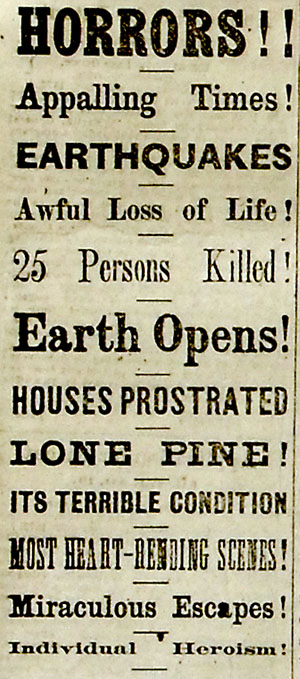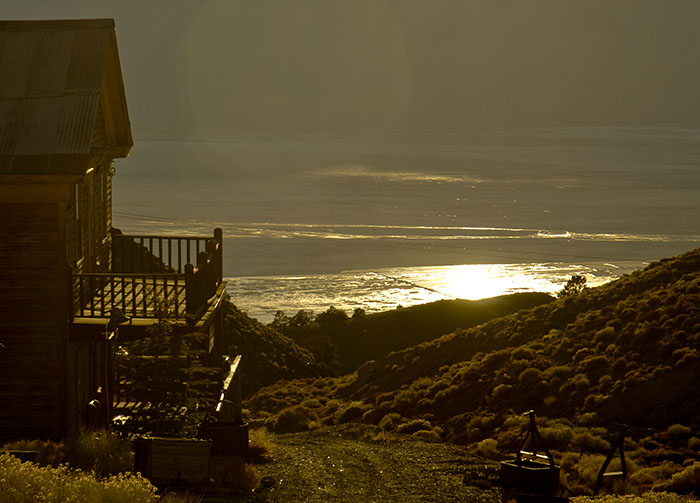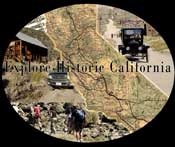Sunday, November 1, while Roger and I prepared for a quiet night
in the Belshaw House as Cerro Gordo caretakers, we experienced a
3.7 earthquake centered in Keeler. The area has been quite
geologically active lately, serving as a haunting reminder
of one of the biggest earthquakes in recorded California
history. We dug into our archives to re-acquaint you with this
earth shaking occurrence and the tremendous power of old mother
nature.
 |
|
Inyo Independent front page headline, March 30,
1872. |
In the earliest hours of March 26, 1872, while
the majority of San Franciscans were asleep in their beds, weather
observer Thomas Tennant recorded a faint earthquake. As time
progressed it was realized that what Thomas had actually felt was an
earthquake that may have been equal or larger in magnitude than the
devastating quake that would hit his own city 34 years later.
Ironically, days later, the San Francisco Real Estate Circular
reported in an editorial "San Francisco is in very little more
danger of a disastrous earthquake than the Eastern States of being
flooded by a overflow of the Atlantic Ocean." Reports were made of
an earthquake awakening people as far south as San Diego, north to
Red Bluff, and east to Elko, Nevada.
A Great & Noble Earthquake
Around two that same morning in March, John
Muir was shaken out of his cabin near Sentinel Rock in Yosemite
Valley. A glad and frightened Muir shouted out, "A noble
earthquake!" and chalked it all up as a great learning experience.
His neighboring Yosemite Valley residents were
fearful, having heard state geologist Dr. Josiah Dwight Whitney's
theories that the floor of the great valley had dropped during some
ancient cataclysm. John Muir disagreed with Whitney's theory, and
found the event to be an opportunity to prove otherwise.
In his 1901 book "Our National Parks", Muir
describes "shocks so violent and varied, and succeeded one another
so closely, one had to balance in walking as if on the deck of a
ship among the waves, and it seemed impossible the high cliffs
should escape being shattered." As he speculated that the Sentinel
Rock rising three thousand feet above him would be shaken down, the
silence that followed the first shockwaves was soon shattered by a
roar as Eagle Rock, some distance away fell into thousands of
boulders.
The resident Yosemite Valley Indians were sure
the angry spirits of the great rocks were trying to kill them.
 |
|
First paragraph of Inyo Independent front quake
story, March 30, 1872. |
For two months, Muir reported trembling rocks.
He joked with neighbors "Come, cheer up; smile a little and clap
your hands, now that kind Mother Earth is trotting us on her knee to
amuse us and make us good." A bucket of water was kept on his cabin
table so he could study the movements. He recorded the changes in
nature around him - rock avalanches, driftwood, and leaf damned
streams, reducing them to nothing in some places, causing them to
roar in others.
Lake levels rose, meadows were smoothed, new
meadows created. Muir was comforted that "storms of every sort,
torrents, earthquakes, cataclysms, convulsions of nature etc.
however mysterious and lawless at first sight they may seem, are
only harmonious notes in the song of creation, varied expressions of
God's love."
Shockwaves Across Owens Valley
The great forces that created a naturalist's
wonder for Muir and frightened his Yosemite Valley neighbors,
wreaked havoc on the lives of the residents of Owens Valley where
the geologic event was centered. The night before the shockwave hit
was described as "spring-like and balmy," with bright stars shining
in the clear dark skies overhead, until 2:30 a.m.
The earth rumbled for three minutes. As the
hours progressed, the earth continued to shake on and off. The next
major aftershock was recorded at 6:30 a.m. The military outpost at
Camp Independence reported up to 200 tremors on through 5 p.m. the
following afternoon.
By April 6, the Inyo Independent
newspaper reported the earth was quieting down. The shocks were
dwindling from twelve to twenty hours apart. The San Francisco
Chronicle reported over a thousand shocks the first week alone.
Camp Independence Crumbles
On January 24, residents of Owens Valley had
been wakened in the night by a shake that caused no damage, and very
little talk. On March 17, another quake was felt, but again, little
noted of it. The seemingly never ending jolt of March 26, however,
would never be forgotten.
 |
| More
of Inyo Independent front quake story, March 30,
1872. |
The sentries of Camp Independence found
themselves to be immediately thrown to the ground. As the earth
trembled throughout the night, no one in camp slept. Beds were
pulled outside, campfires were relit. Major Harry Egbert would
later report that only Private J. Lutz and his wife, who was a
laundress, were injured. The surgeon's house, guard house, mess
hall, cook house, First Sergeant's house, storehouse, blacksmith's
shop and two laundress' quarters were almost completely destroyed.
These buildings, like so many others throughout the Owens Valley
during this time period, were built with adobe bricks.
The barracks, commissary, storehouse, hospital
and remainder of the officers' quarters received enough damage to be
deemed unsafe. They, too, were of adobe brick. Broken timbers
were salvaged to build temporary shelters for troops and
laundresses, cooking and dining. Canvas structures were erected for
the officers and their families.
Residents In Rubble
Outside of Camp Independence, the town of
Independence itself was completely destroyed. The houses, adobe like
the military buildings, were gone. One resident, Jacob Vagt, and his
wife, found themselves completely covered by brick from their adobe
home. Their baby was suffocated before they could rescue it from the
fallen bricks, yet they themselves only suffered bruises and cuts.
Nearby Lone Pine, was most devastated by the
temblor. All businesses and residences built entirely of adobe were
now piles of rubble. The soldiers from Camp Independence dug for
bodies. Twenty seven people were either killed instantly or later
died from injuries. Dozens more suffered serious injuries.
The Loomis brothers store was hit severely.
Rockwell Loomis was buried under the debris from the building that
belonged to him and his brother, Albert. A neighbor, William
Covington, caught powder kegs just as a fire erupted nearby. With
the earth still shaking beneath him, Covington moved the kegs to
safety, and continued digging to find Loomis. Loomis lost an ear
and most of his scalp. Survivors continued on to rescue others.
John McCall of Lone Pine wrote a letter after
the event that told how he, his wife and little daughter were buried
in ruins for an hour and a half. Four feet of adobe piled on top of
them. They lived nearly a mile and a half from anyone else, and
were almost dead when finally discovered and rescued.
 |
|
Inyo Independent story April 6, 1872, listing
injured people. |
Mr. Burkhardt and his neighbor, Mr. Lubken,
could hear Mrs. Burkhardt screaming after their home collapsed, but
there were no sounds of his son who was buried as well. Burkhardt
reportedly cried, "The Old Lady's screaming, so she's all right.
Let her lay. Well get the boy first." Young Fred was dug out and
revived and then Mrs. Burkhardt was retrieved uninjured.
Needless to say the poor woman was quite
riled, in spite of her rescue, because she had heard every word that
her husband had said to his friend.
The San Francisco Chronicle reported the
tragic death of Antonia Montoya, a young Mexican woman sharing her
couch with a paramour. When the shock hit they were both startled
out of their sleep. Antonia began screaming and praying. The man
jumped out of bed and leaped clear of the building as the roof and
walls began to tumble down. Unfortunately for Antonia, she was
caught in bed by the bricks and could only scream for help. Her
paramour never paused even for a moment to rescue her. Sadly,
Antonia perished.
In Bishop Creek to the north, the Inyo
Independent wrote of a young gentleman who was sitting up with
his young lady friend just as the shock hit. She fainted into his
arms and did not recover very quickly. The next day the young man
swore he would give "$20 a shot for earthquakes when setting up with
an offish gal."
Strange Phenomenon
The great Lone Pine Earthquake appeared to be
centered from Lone Pine to Big Pine. Both Lone Pine and Big Pine
reported large fissures, some with crevasses up to two hundred feet
deep Stories were told of the Owens River changing its course, and
new lakes, one of which is the present day Lake Diaz (where the Diaz
Ranch once stood), were created.
At George's Creek, water burst from the ground
and came up into a cabin that had only a dirt floor, flooding out
the occupants. A horse's hoof was said to have protruded from the
ground where another crack had opened then closed. At Fish Springs,
an ox was supposedly swallowed by the crack, his tail the only
visible sign above the ground that he had ever been there. Nearby,
another ox was found dead, possibly from fright, as there was no
sign of injury.
Men camping near the river at a bridge south of
Lone Pine were building a boat. After the earthquake hit they said
they saw fish thrown up on the banks because the water had
disappeared. They gathered up the fish and cooked them for
breakfast, then continued on building their boat, even though they
weren't sure there would be a need for one any more.
Many reports were made of streams of fire
coming down the mountains, which turned out to be the friction from
the rocks hitting each other during the motion of the earthquake.
Animals were heard making strange noises in terror. Horses ran off
never to be found or perhaps disappeared into the large fissures in
the ground. Stories of phenomenon such as these were told throughout
Owens Valley. The earth gurgled and burped for weeks before slight
tremors occurred, and sounds similar to a great blasting or heavy
artillery fire were heard.
Residents of the mining town of Swansea stood
on the shore of Owens Lake watching as the lake receded to the
center of its' lake bed like a tidal wave. They were sure they would
be drowned, but were too frightened to move away. As the water swept
towards them about 200 feet, they were spared and there was no
damage. Owens Lake was now shallower at Swansea Landing than at the
opposite shore on the Sierra Nevada (west) side of the valley.
Picking Up The Pieces
The total damage to Camp Independence totaled
$26,000 and $237,000 for all of Inyo County. Lone Pine was damaged
the most, with an estimated $132,000. Damages continued to mount as
time went on and more tremors occurred. Many communities throughout
California raised relief money.
The silver boom town of Cerro Gordo, high in
the Inyo Mountains overlooking Owens Valley, sustained little or no
damage, but raised $800 to help their less fortunate neighbors down
the hill. In time, Camp Independence and surrounding towns were
rebuilt. Wood frame buildings sprouted where adobe walls had stood
before the earthquake hit.
By July 4, 1872, people who were devastated by
nature's shockwaves were moving on with their lives. In addition to
the traditional Independence Day festivities, there would be a boat
ride on Owens Lake that had nearly swallowed up the town of Swansea
only months before. James Brady had built a steamboat and named it
the Bessie Brady after his daughter. Everyone formally
invited to ride the steamboat across the lake and picnic at the
landing afterwards. Life was returning to normal in Owens Valley.
 |
|
Water on Owens Lake reflects the setting sun in this
present day photo from Cerro Gordo. The American Hotel,
built in 1871, is at the left. Owens Lake was 30 feet
deep and its waters sustained a seismic wave when the
Lone Pine earthquake shook in 1872. Cerro Gordo was
shaken, but mostly intact after the quake and residents
collected $800 to assist their neighbors in the Valley. |
Bibliography
The Boys In The Sky Blue Pants
by
Dorothy Clora Cragen
Pioneer
Publishing Company
Deepest Valley: Guide to Owens Valley Owens Valley and Its Mountain
Lakes, Roadsides and Trails
Edited by
Ginny Schumacher
Sierra
Club, San Francisco
The Story of Inyo
By W. A.
Chalfant
Chalfant
Press, Inc.
Inyo Independent newspaper
Courtesy of Laws Museum, Bishop, Calif.
Thanks to the
following websites:
Museum of the City of San Francisco
"Our National Parks" John Muir
|
